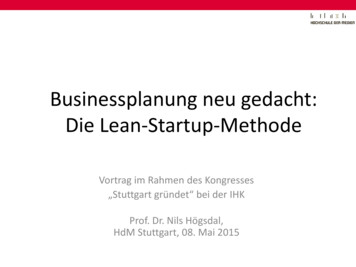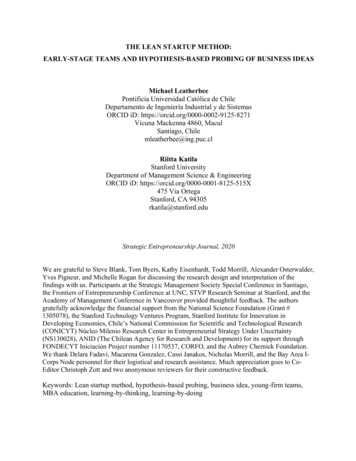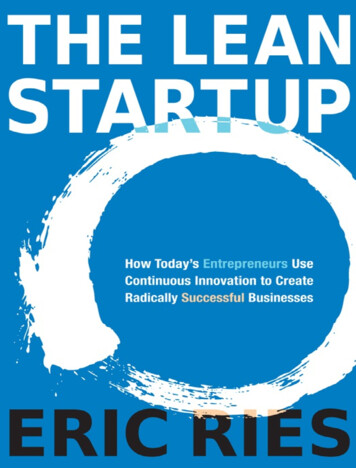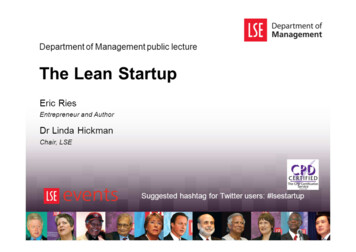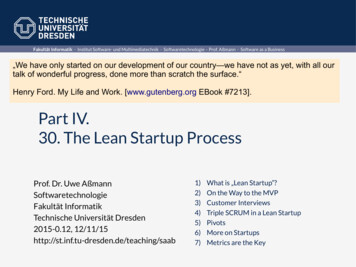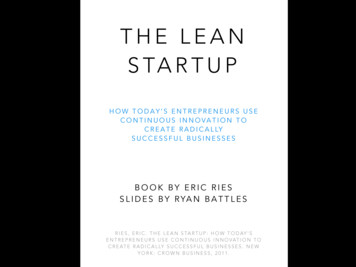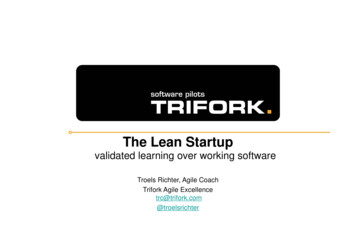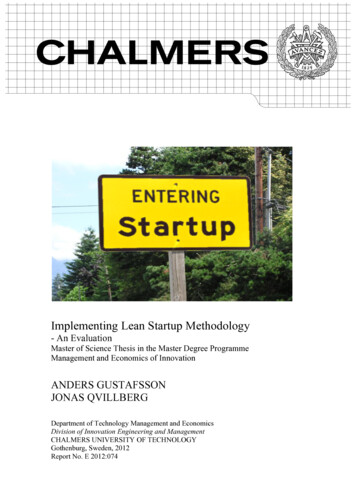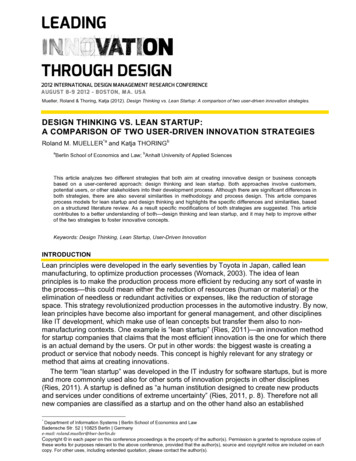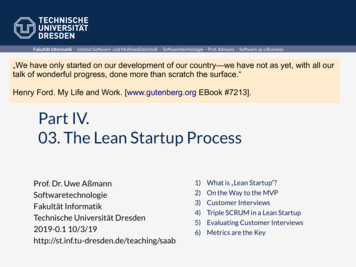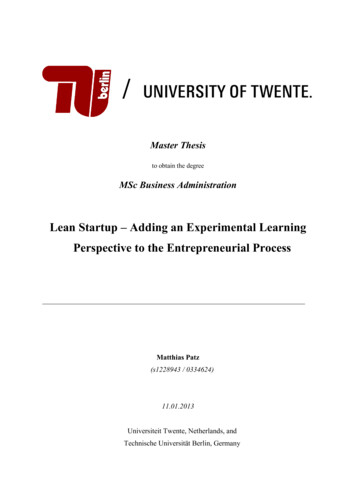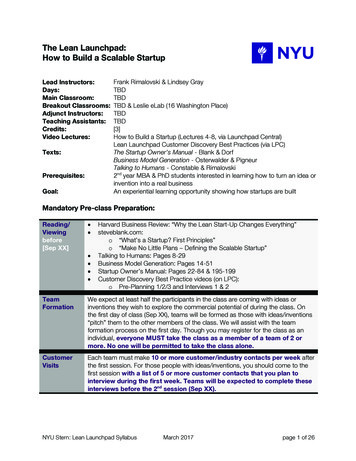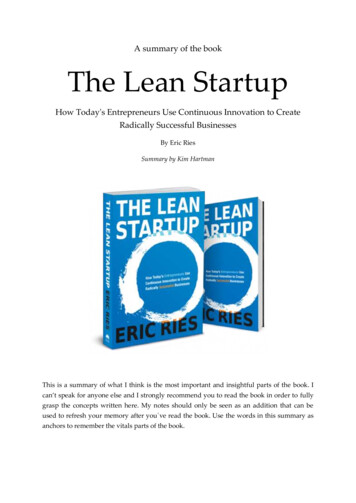
Transcription
A summary of the bookThe Lean StartupHow Today's Entrepreneurs Use Continuous Innovation to CreateRadically Successful BusinessesBy Eric RiesSummary by Kim HartmanThis is a summary of what I think is the most important and insightful parts of the book. Ican’t speak for anyone else and I strongly recommend you to read the book in order to fullygrasp the concepts written here. My notes should only be seen as an addition that can beused to refresh your memory after you ve read the book. Use the words in this summary asanchors to remember the vitals parts of the book.
More book summaries at www.kimhartman.seContact me at Kim.hartman@hyperisland.seContentsDescription from amazon . 2Part One - Vision. 3Chapter 1 – Start . 3Chapter 2: Define . 4Chapter 3: Learn . 5Validated Learning . 5Chapter 4: Experiment . 6Part two: Steer . 7The feedback loop. 7Chapter 5: Leap . 8Chapter 6: Test . 9Early adopters . 9Chapter 7: Measure . 11Innovation accounting . 11Metrics . 12Chapter 8: Pivot or Preserve . 14Part three – Accelerate . 16Chapter 9: Batch . 18Chapter 10: Grow . 21Chapter 11: Adapt . 23The five why s . 23Chapter 12: Innovate . 25The innovation sandbox . 25More book summaries . 271
More book summaries at www.kimhartman.seContact me at Kim.hartman@hyperisland.seDescription from amazonEric Ries defines a startup as an organization dedicated to creating something new underconditions of extreme uncertainty. This is just as true for one person in a garage or a group ofseasoned professionals in a Fortune 500 boardroom. What they have in common is a missionto penetrate that fog of uncertainty to discover a successful path to a sustainable business.The Lean Startup approach fosters companies that are both more capital efficient and thatleverage human creativity more effectively. Inspired by lessons from lean manufacturing, itrelies on “validated learning,” rapid scientific experimentation, as well as a number ofcounter-intuitive practices that shorten product development cycles, measure actual progresswithout resorting to vanity metrics, and learn what customers really want. It enables acompany to shift directions with agility, altering plans inch by inch, minute by minute.Rather than wasting time creating elaborate business plans, The Lean Startup offersentrepreneurs - in companies of all sizes - a way to test their vision continuously, to adaptand adjust before it’s too late. Ries provides a scientific approach to creating and managingsuccessful startups in a age when companies need to innovate more than ever.2
More book summaries at www.kimhartman.seContact me at Kim.hartman@hyperisland.sePart One - VisionChapter 1 – StartThe myth of the loss of manufacturing capabilities: The huge productivity increases madepossible by modern mismanagement and technology have created more productivitycapacity than firms know what to do with. More output, less jobs.Lean thinking: drawing on the knowledge and creativity of individual workers, shrinkingbatch sizes, just-in-time production and inventory control, acceleration of cycle times.Progress measure: Instead of measuring progress in manufacturing by the production ofhigh-quality physical goods, the lean startup measure progress through validated learning.Productivity: When people are used to evaluating their productivity locally, they feel that agood day is one in which they did their job well all day. The lean startup asks people tofigure out the right thing to build – the thing customers want and will pay for – as quickly aspossible.Build-measure-learn feedback loop: instead of making a lot of assumptions, you can makeconstant adjustments with a steering wheel called build-measure-learn. Through this processwe can learn if and when to make a sharp turn – a pivot.3
More book summaries at www.kimhartman.seContact me at Kim.hartman@hyperisland.seChapter 2: DefineInnovation factory: A company s only sustainable path to long-term economic growth is tobuild an “innovation factory” that uses lean startup techniques to create disruptiveinnovations on a continuous basis.Culture and systems: It’s moving leaders from playing Caesar with their thumbs up anddown on every idea to – instead – putting in a culture and the systems so that teams canmove and innovate at the speed of the experimentation system.4
More book summaries at www.kimhartman.seContact me at Kim.hartman@hyperisland.seChapter 3: LearnValidated LearningValidated learning is not after-the-fact rationalization or a good story designed to hidefailure. It is a rigorous method for demonstrating progress when one is embedded in the soilof extreme uncertainty in which startups grow. Validated learning is the process ofdemonstrating empirically that a team has discovered valuable truths about a startupspresent and future business prospects. It is more concrete, more accurate, and faster thanmarket forecasting or classical business planning.Learning is the essential unit of progress for startups. The effort that is not absolutelynecessary for learning what customers want can be eliminated. This is validated learning,because it is always demonstrated by positive improvements in the startups core metrics.Validated learning is backed up by empirical data collected from real customers.The way forward is to learn to see every startup in any industry as a grand experiment. Thequestion is not “can this product be built?” but “can this product be built?” and “can webuild a sustainable business around this set of products and services.Your job is to find a synthesis between your vision and what customers would accept; itwasn’t to capitulate to what customers thought they wanted or to tell customers what theyought to want.True startup productivity: systematically figuring out the right things to build. In the leanstartup, every product, every feature, every marketing campaign – everything a startup does– is understood to be an experiment designed to achieve validated learning.Lean thinking: Lean thinking defines value as providing benefit to the customer, anythingelse is waste. In a manufacturing business, customers don’t care how the product isassembled, only that it works correctly. But in a startup, who the customer is and what thecustomer might find valuable are unknown, part of the very uncertainty that is an essentialpart of the definition of a startup.5
More book summaries at www.kimhartman.seContact me at Kim.hartman@hyperisland.seChapter 4: ExperimentOne of the most important lessons of the scientific method – if you cannot fail, you cannot learn.The experiment phase: it begins with a clear hypothesis that makes predictions about whatis supposed to happen. Startup experimentation is guided by the startups vision. The goal ofevery startup experiment is to discover how to build a sustainable business around thatvision. Even when experiments produce a negative result, those failures prove instructiveand can influence strategy. In the lean startup model, an experiment is more than just atheoretical inquiry; it is also a first product.The two most important assumptions entrepreneurs make are: The value hypothesis – test whether a product or service really delivers value tocustomers once using it. The growth hypothesis – test how new customers will discover a product or service.The product manager usually says “I want this”, and the engineer answers “I am going tobuild that”.Instead answer 4 questions:1. Do consumers recognize that they have the problem you are trying to solve?2. If there was a solution, would they buy it?3. Would they buy it from us?4. Can we build a solution for that problem?Success is not delivering a feature; success is learning how to solve the customer’s problem.6
More book summaries at www.kimhartman.seContact me at Kim.hartman@hyperisland.sePart two: SteerThe feedback loopIdeas build product measure data learn ideas and so on (circle)Image source (thanks)Minimizing the total time: Many people have training that emphasizes one element of thefeedback loop. But having the best business idea or the best designed product isn’t enough;we need to focus our energies on minimizing the total time through this feedback loop.Minimum Viable Product: Once clear on the leap-of-faith decisions, the first step is to enterthe build phase as quickly as possible with a minimum viable product – MVP. The MVP isthat version of the product that enables a full turn of the build-measure-learn loop with aminimum amount of effort and the least amount of development time.Learning milestones: an alternative to traditional business and product milestones. Learningmilestones are useful for entrepreneurs as a way of assessing their progress accurately andobjectively.7
More book summaries at www.kimhartman.seContact me at Kim.hartman@hyperisland.seChapter 5: LeapStartup strategy: For startups, the role of strategy is to help figure out the right questions toask.The first challenge for an entrepreneur is to build an organization that can test theseassumptions systematically. The second challenge, as in all entrepreneurial situations, is toperform that rigorous testing without losing sight of the company s overall vision.Leap-of-faith assumptions: The riskiest elements of a startup plan are the leap-of-faithassumptions. The two most important assumptions are the value hypothesis and the growthhypothesis. These give rise to tuning variables that control a startups engine of growth. Eachiteration of a startup is an attempt to rev this engine to see if it will turn. Once it is running,the process repeats, shifting into higher and higher gears.Example leap of faith: will break or make your business. In the iPod business, one of thoseleaps of faith was that people would pay for music.Genchi Gembutsu: “Go and see for yourself”. Means that business should be based on deepfirsthand knowledge. Until you have seen something for yourself firsthand you cannot besure you really understand any part of the business problem.External customer data: The facts that we need to gather about customer exist only outsidethe building.Customer archetype: Early contact with the customer clarifies a basic coarse level that wecan use to craft a customer archetype – a brief document that seeks to humanize theproposed target customer.8
More book summaries at www.kimhartman.seContact me at Kim.hartman@hyperisland.seChapter 6: TestMVP definition: A minimum Viable Product helps entrepreneurs start the process oflearning as quickly as possible. It is not necessarily the smallest product imaginable, though;it is simply the fastest way to get through the build-measure-learn feedback loop with theminimum amount of effort. MVP is designed not just to answer product design or technicalquestions. Its goal is to test fundamental business hypotheses. The MVP is only the first stepon a journey of learning. Down that road – after many iterations – you may learn that someelement of your product or strategy is flawed and decide it is time to make a change (pivot)to a different method for achieving your vision.The concierge MVP: in a concierge MVP, a personalized service is not the product but alearning activity designed to test the leap of faith assumptions to the company s growthmodel. Without a formal growth model, many companies get caught in the trap of beingsatisfied with a small profitable business when a pivot (change in course or strategy) mightlead to a more significant growth.MVP rule: When building your MVP, remove any feature, process or effort that does notcontribute directly to the learning you seek. Even a low quality MVP can act in service ofbuilding a great high-quality product.Constant feedback: Bring continually in people to react to mockups, prototypes andsimulations.Early adoptersBefore new products can be sold successfully to the mass market, they have to be sold toearly adopters. These people are a special breed of customer. They accept – in fact prefer – an80 percent solution; you don’t need a perfect solution to capture their interest. Early adoptersuse their imagination to fill in what a product is missing. They prefer that state of affairs,because what they care about above all is being the first to use or adopt a new product ortechnology. Early adopters are suspicious of something that is too polished; if it’s ready foreveryone to adopt, how much advantage can one get by being early?Wizard of Oz testing: in WoOT, customers believe they are interacting with the actualproduct, but behind the scenes human beings are doing the work. Very inefficient, but easyto build on micro scale.High-quality experiences: Most business philosophies focus on producing high-qualityexperiences for customers as a primary principle. This presupposes that the companyalready knows what attributes of the product the customer will perceive as worthwhile, andthis is a risky assumption in a startup. If we don’t know who the customer is, we do notknow what quality is.9
More book summaries at www.kimhartman.seContact me at Kim.hartman@hyperisland.seWe must always ask: what if the user doesn’t care about the design in the same way we do?We must be willing to set aside our traditional professional standards to start the process ofvalidated learning as soon as possible.A head start is rarely large enough to matter, and time spent in stealth mode – away fromcustomers – is unlikely to provide a head start. The only way to win is to learn faster thananyone else.10
More book summaries at www.kimhartman.seContact me at Kim.hartman@hyperisland.seChapter 7: MeasureA startup s job is to:1. Rigorously measure where it is right now, confronting the hard truths thatassessment reveals and then 2. Device experiments to learn how to move the real numbers closer to the idealreflected in the business plan.Innovation accountingInnovation accounting: We all need a disciplined, systematic approach to figuring out if weare making progress and discovering if we are actually achieving validated learning. This iscalled innovation accounting; an alternative to traditional accounting designed specificallyfor startups, and begins by turning the leap-of-faith assumptions into a quantified financialmodel. IA works in three steps:1. Use a MVP to establish real data on where the company is right now2. Startups must attempt to tune the engine from the baseline toward the ideal.3. After the startup has made all the micro changes and product optimizations it canmove its baseline toward the ideal, the company reaches a decision point: pivot orpreserve.The innovation accounting framework makes it clear when the company is stuck and needsto change direction.The importance of innovation accounting: Only 5 % of entrepreneurship is the big idea, thebusiness model, the whiteboard strategizing, and the splitting up of the spoils. The other 95% is the gritty work that is measured by innovation accounting: product prioritizingdecisions, deciding which customers to target or listen to, and having the courage to subjecta grand vision to constant testing and feedback.Learning milestone: The MVP provides the first example of a learning milestone. An MVPallows a startup to fill in real baseline data in it growth model – conversion rates. Sign upand trial rates, customer life value etc. – and this is valuable as the foundation for learningabout customers and their reactions to product even if that foundation begins with extremelybad news.Tuning the engine: Once the baseline has been established, the startup can work toward thesecond learning milestone: tuning the engine. Every product development, marketing otherinitiative that a startup undertakes should be targeted at improving one of the drivers of itgrowth models.11
More book summaries at www.kimhartman.seContact me at Kim.hartman@hyperisland.sePivot or preserve: If we are not moving the drivers of our business model, we are notmaking progress. That becomes a sure sign that it is time to pivot. When a company pivots, itstarts the process all over again, reestablishing a new baseline and then tuning the enginefrom there. The sign of a successful pivot is that these engine-tuning activities are moreproductive after the pivot than before.The sign of a successful pivot: the new experiments you run are overall more productivethan the experiments you were running before.Pattern for making a pivot or preserve: poor quantitative results force us to declare failureand create the motivation, context, and space for more qualitative research. Theseinvestigations produce new ideas – new hypotheses – to be tested, leading to a possiblepivot. Each pivot unlocks new opportunities for further experimentation, and the cyclerepeats. Each time we repeat this simple rhythm: establish the baseline, tune the engine, andmake a decision to pivot or preserve.Cohort analysis: this is one of the most important tools of startup analytics. Instead oflooking at cumulative totals or gross numbers such as total revenue and total number ofcustomers, one looks at the performance of each group customers that comes into contactwith the product independently. Each group is called a cohort.MetricsActionable metrics: the kind of metrics we use to judge our business and our learningmilestones.Farbs user stories: Instead of writing a specification for a new feature that described it intechnical terms, Farb would write a story that described the feature from the point of view ofthe customer.Split test benefits: split tests almost always save tremendous amount of time in the long runby eliminating work that doesn’t matter to customers. It also helps teams refine theirunderstanding of what customers want and don’t want.The 3 mA s of metrics: Actionable Accessible AuditableActionable metrics: For a report to be considered actionable, it must demonstrate clear causeand effect. Otherwise it is a vanity metric. When cause and effect is clearly understood,people are better able to learn from their actions. Human beings are innately talentedlearners when given a clear and objective assessment.12
More book summaries at www.kimhartman.seContact me at Kim.hartman@hyperisland.seAccessible metrics: departments too often spend their energy learning how to use data to getwhat they want rather than as genuine feedback to guide their future actions. Remember thatmetrics are people, too. Everyone must understand the reports.Auditable metrics: We must ensure that the data is credible to employees.13
More book summaries at www.kimhartman.seContact me at Kim.hartman@hyperisland.seChapter 8: Pivot or PreservePivot definition: A structured course correction designed to test a new fundamentalhypothesis about the product, strategy and engine of growth. A pivot requires that we keepone foot rooted in what we have learned so far, while making a fundamental change instrategy in order to seek even greater validated learning.Pivot sooner than later: Ask most entrepreneurs who have decided to pivot and they willtell you that they wish they had made the decision sooner.The land of the living dead: Happens when a company has achieved a modicum of success– just enough to stay alive – but is not living up to the expectations of its founders andinvestors. Companies that cannot bring themselves to pivot to a new direction on the basis offeedback from the marketplace can get stuck in the land of the living dead, neither growingenough nor dying, consuming resources and commitment from employees and otherstakeholders but not moving ahead.Learning Milestones goal: The goal of creating learning milestones is not to make thedecision easy; it is to make sure that there is relevant data in the room when it comes time todecide.The Runaway: The true measure of runaway is how many pivots a startup has left: thenumber of opportunities it has to make a fundamental change to its business strategy.Vanity metrics prevents pivoting: Vanity metrics can allow entrepreneurs to form falseconclusions and live in their own private reality. When an entrepreneur has an unclearhypothesis, it’s almost impossible to experience complete failure, and without failure there isusually no impetus to embark on the radical change a pivot requires. You will alwayssucceed - in seeing what happens. You won’t know whether to pivot or preserve.Common with pivots: it is not necessary to throw out everything that came before and startover. Instead, it is about repurposing what has been built and what has been learned to finda more positive direction.From early adopters to mainstream: The rationale for building low-quality MVPs is thatdeveloping any features beyond what early adopters require is a form of waste. Once youhave found success with early adopters, you want to sell to mainstream customers.Mainstream customers have different requirements and are much more demanding.The heart of the lean startup: A pivot is not just an exhortation to change. It is a special kindof structured change designed to test a new fundamental hypothesis about the product,business model and engine of growth. It is the heart of the lean startup method.Types of pivots:14
More book summaries at www.kimhartman.seContact me at Kim.hartman@hyperisland.se Zoom-in pivot: What preciously was considered a single feature in a productbecomes the whole product. Zoom-out pivot: What was considered as the whole product becomes a single featureof a much larger product. Customer segment pivot: The product hypothesis is partially confirmed, solving theright problem, but for a different customer than originally anticipated. Customer need pivot: The product hypothesis is partially confirmed: the targetcustomer has a problem worth solving, just not the one that was originallyanticipated. Platform pivot: Refers to a change from an application to a platform or vice versa. Business architecture pivot: For example when a startup goes from high margin/lowvolume to mass market or vice versa. Value capture pivot: how do companies capture value? Engine of growth pivot: A company changes its growth strategy to seek faster ormore profitable growth. Channel pivot: Is the recognition that the same basic solution could be deliveredthrough a different channel with greater effectiveness. Technology pivot: When discovering a technology to achieve the same solution byusing a completely different technology.15
More book summaries at www.kimhartman.seContact me at Kim.hartman@hyperisland.sePart three – AccelerateImage source (thanks)Structures: Startups need organizational structures that combat the extreme uncertainty thatis a startups chief enemy.Value in a startup: The critical first question for any lean transformation is: which activitiescreate values and which are a form of waste? Once you understand this distinction, you canbegin using lean techniques to drive out waste and increase the efficiency of the valuecreating activities. Value in a startup is not the creation of stuff, but rather validated learningabout how to build a sustainable business. What products do customers really want? Howwill our business grow? Who is our customer? Which customer should we listen to andwhich should we ignore.Just-in-time: Just as lean manufacturing has purchased a just-in-time approach to buildingproducts, reducing the need for in-process inventory; Lean startups practice just-in-timescalability.16
More book summaries at www.kimhartman.seContact me at Kim.hartman@hyperisland.seSustainable growth follows one of three engines of growth: Paid Viral StickyChoosing engine of growth: By identifying which engine of growth a startup is using, it canthen direct energy where it will be most effective in growing the business. Each enginerequires a focus on unique metrics to evaluate the success of new products and prioritizenew experiments.Sustainable AND disruptive: Today companies must learn to master a managementportfolio of sustainable AND disruptive innovation.17
More book summaries at www.kimhartman.seContact me at Kim.hartman@hyperisland.seChapter 9: BatchSmall batches: Every Lean startup technique we have discussed so far works its magic intwo ways: by converting push methods to pull and reducing batch sizes. The biggestadvantage of working in small batches is that quality problems can be identified muchsooner. Working in small batches ensures that a startup can minimize the expenditure oftime, money, and effort that ultimately turns out to have been wasted. Small batches letpeople discover the truth faster.Example small batches vs. large batches - letter folding:Fold all of the letters, attach the seal and put on the stamps. This approach is called singlepiece flow in lean manufacturing. It works because of the surprising power of small batches.Single-piece flow is so named because it has a batch size of one. The extra time required tosort, stack, and move around the large piles of half-complete envelopes when it’s done theother way. The small-batch approach produces a finished product every few seconds,whereas the large-batch approach must deliver all the products at once, at the end.Even if the amount of time that each process took was exactly the same, the small batchproduction approach still would be superior. Imagine that the letter s didn’t fit in theenvelopes. With the large-batch approach, we wouldn’t find that out until nearly the end.Toyota s small batches: Instead of buying large specialized machines that could producethousands of parts at a time, Toyota used smaller general-purpose machines that couldproduce a wide variety of parts in small batches. This required figuring out ways toreconfigure each machine rapidly to make the right part at the right time. By focusing on this“changeover time”, Toyota was able to produce entire automobiles by using small batchesthroughout the process.Toyota did not ask workers to work faster but reimagined and restructured the work thatneeded to be done. Every investment in better tools and process had a corresponding benefitin terms of shrinking the batch size of work. The smaller batch sizes created a greaterdiversity of products and Toyota could therefore serve its smaller, more fragmented marketsand still compete with the mass producers.Toyotas andon chord: an assembly line works best when it is functioning smoothly, rollingcar off the end of the line. The andon chord can interrupt this careful flow as the line ishalted repeatedly. However, the benefits of finding and fixing problems faster outweigh thiscost.Large batches: Behind the scenes, in the development and design of the product itself, largebatches are still the rule. The work that goes into the development of a new product proceedson a virtual assembly line.18
More book summaries at www.kimhartman.seContact me at Kim.hartman@hyperisland.seExample of Continuous deployment in the software industry:1. Hardware becoming softwareThe latest phones and tablets computers are little more than a screen connected to theinternet. Almost all of their value is determined by their software. What can be builtout of software can be modified much
Startup experimentation is guided by the startups vision. The goal of every startup experiment is to discover how to build a sustainable business around that vision. Even when experiments produce a negative result, those failures prove instructive and can influence strategy. In the lean startup model, an experiment is more than just aFile Size: 569KB
